Military orders and medals of the Soviet Union. Medals of the series "For Defense"
The following medals of this “series” appeared in May 1944 of the year. 1 May 1944 two new combat medals were approved: "For the Defense of Moscow" and "For the Defense of the Caucasus". At the end of December 1944, December 5, another medal was established - For the Defense of the Soviet Arctic. The last medal of the series appeared after the Great Patriotic War, 16 years after its completion (a unique case). 21 June 1961, the decree of the Presidium of the USSR Armed Forces established the military medal "For the Defense of Kiev."
All medals were of the same type and were distinguished by their obverse and pentagonal pad. All medals of this type were made of brass (a double or multicomponent copper-based alloy). Initially, the medals of this series were planned to be made of stainless steel, but 27 March 1943, the material from which the medals were made, officially became brass. All medals had the shape of a circle with a diameter of 32 mm. On the reverse of all the medals there was an inscription “FOR OUR SOVIET MOTHERLAND” (all the letters of the inscription were in capital letters), above the inscription there was an image of a sickle and hammer. The author of the approved sketches of six medals, which were established by 22 December 1942 of the year and 1 of May 1944, was the artist N. I. Moskalev.
Medal "For the Defense of Leningrad"
The medal "For the Defense of Leningrad" was awarded to all participants in the defense of the city. Not only the military, but also the civilian population, which contributed to its defense, worked on the construction of fortifications, worked at enterprises and institutions of the city, was involved in the protection of public utilities, fire fighting, and protected Leningrad from German attacks aviation, worked in the organization of public catering, was engaged in the maintenance of transport and communications, looked after the wounded and sick, and also participated in other activities that contributed to the defense of the city.

On the obverse of the medal, a group of Red Army men, Red Navy men, as well as workers and women workers, who stood with the rifles in front of the Admiralty, was depicted. Above there was a five-pointed star with an inscription on the edge "FOR DEFENSE OF LENINGRAD" (all capital letters). The medal was connected to a standard pentagonal shoe with a ring and an ear. The pad was covered with an 24 mm silk moiry ribbon that is olive green. Along the ribbon in the middle was a green stripe 2 mm thick.
The persons who were awarded this medal also had the right to receive the medal “In Memory of the 250 Anniversary of Leningrad” later established. Awarding the medal "For the Defense of Leningrad" began immediately after its establishment. Before 1945, 600 thousands of awards were presented to blockaders. Information about all these people as of 1945 year was stored in the created blockade museum, there were all 6 volumes containing the names of the awarded. On the 1985 year, about 1 470 000 people were awarded with this medal, among which there were about 15 thousands of blockade children and teenagers.
Medal "For the Defense of Sevastopol"
This medal was awarded to all participants in the defense of the city - the military and civilians who took part in the defense of Sevastopol, which lasted 250 days - from October 30 1941 of the year to July 4 of the year 1942. The medal could be awarded to those who participated in the defense of the city throughout the entire period, and those who were members of the defense, but were evacuated from Sevastopol during his defense due to his injury, illness or government measures.
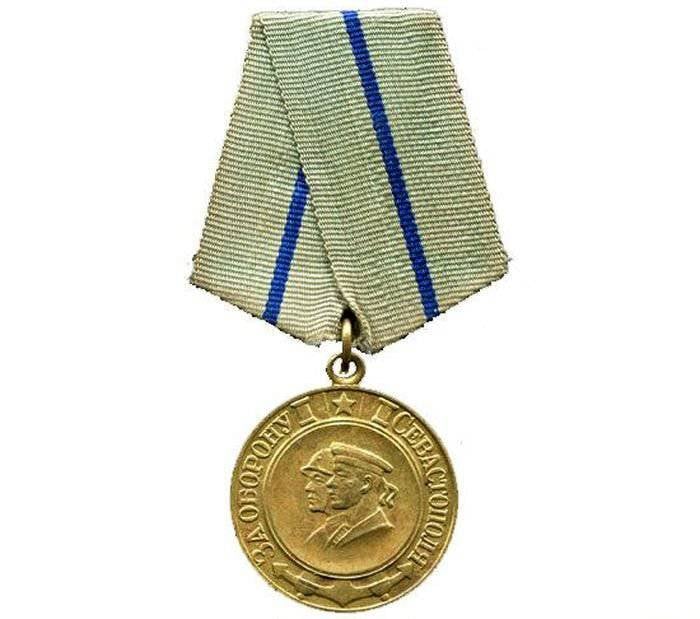
On the obverse of the medal there was a bust of the Red Navy and the Red Army man. On the surrounding frame medal width 5 mm were protruding from under the center circle anchors and the ends of the two gun barrels. A five-pointed star was placed at the top of the frame, the inscription “FOR THE SEVASTOPOL'S DEFENSE” (all capital letters) was located along the circumference. The medal was suspended from a standard pentagonal block with an olive moire silk ribbon. The width of the tape is standard - 24 mm, on the tape in the middle there was a blue longitudinal strip width 2 mm.
The medal "For the Defense of Sevastopol" was awarded not only to individuals, but also periodicals. For example, this award was awarded to the newspaper Krymskaya Pravda. As of January 1, the 1995 medal “For the Defense of Sevastopol” was awarded 52 540 times.
Medal "For the Defense of Stalingrad"
This medal was awarded to all participants in the defense of the city, both military and civilian, who were directly involved in the defense of Stalingrad from July 12 to November 19 November 1942. A total of this medal was awarded to the order of 759 560 people (according to the information on 1 January 1995 of the year). In Volgograd, on the building of the headquarters of one of the military units today you can see a huge wall panel depicting this medal.
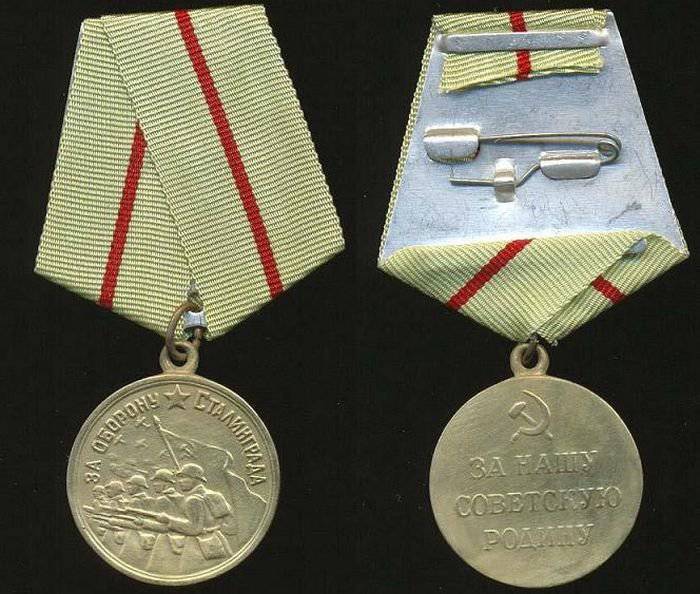
On the obverse of the medal, the artist depicted a group of Soviet fighters with rifles at the ready, which were located against the backdrop of a waving banner. On the left side of this exposure it was possible to distinguish the outlines of aircraft flying one after another, as well as moving tanks. At the top of the coin was the inscription “FOR THE DEFENSE OF STALINGRAD” (all capital letters), as well as a five-pointed star. The medal was attached to a standard pentagonal block, which was covered with olive silk moire ribbon, the width of the tape is 24 mm. A small red strip 2 mm wide was longitudinally running in the middle of the tape.
"Medal for the defense of Odessa"
The medal “For the Defense of Odessa” was awarded to all those who participated in the defense of Odessa from August 10 to October 16 1941 (military and civilians). The medal was awarded on the basis of documentary evidence that certified the participation of citizens in the defense of the city. Such documents could be issued by the commanders of military units, the Odessa Oblast, as well as the city Soviets of Workers' Deputies, and the heads of various military medical institutions. At 1985 year, about 30 thousand medals "For the Defense of Odessa" were issued.
On the obverse of the medal there were figures of the Red Army and Red Navy, armed with rifles. They were located on the background of lighthouses and the sea shore. Above the figures was placed the inscription "FOR THE DEFENSE OF ODESSA" (all capital letters). At the beginning and end of the inscription were small five-pointed stars. The medal was attached to a standard pentagonal block, which was covered with an olive silk ribbon 24 mm wide. In the middle of the tape was a longitudinal blue stripe width 2 mm.
Medal "For the defense of Moscow"
The medal "For the Defense of Moscow" was established by the Decree of the USSR Supreme Council on 1 May 1944. The medal was awarded to the military and civilians who participated in the defense of the capital for at least 1 a month during the defense of the city from October 19 1941 to January 25 1942 in January. In addition, participants in the defense of the hero-city of Tula, as well as partisans of the Moscow region, were awarded this medal. As of January 1, 1995 was awarded this medal to approximately 1 028 600 people.
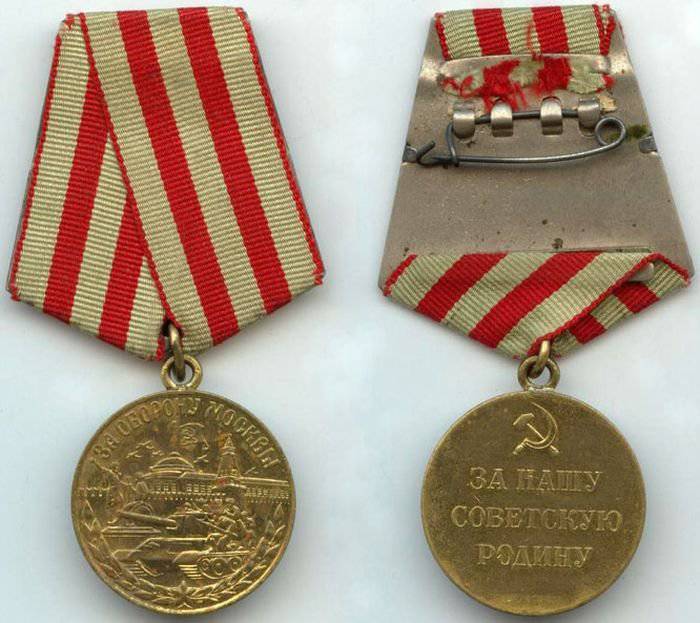
On the obverse of the medal was placed the wall of the Kremlin, on its background was located the tank T-34, which housed a group of Red Army soldiers. On the right side of the sketch was the Kremlin tower, on the left side - a monument to Minin and Pozharsky. Above the Kremlin wall was the dome of the government building with the flag of the USSR. Airplanes flew over the dome. The inscription “FOR MOSCOW DEFENSE” (all capital letters) was placed in the upper part of the medal. A laurel wreath and an image of a small five-pointed star were also located in the lower part along the circumference. The medal was attached to a standard block, which was covered with a silk ribbon 24 mm wide. There were three olive longitudinal strips (in 5 mm) and 2 in red strips (in 4 mm) on the tape.
Medal "For the defense of the Caucasus"
This medal was awarded to all participants of the heroic defense of the Caucasus (both military and civilian population). It was awarded to those who, at least 3 months in the period from July 1942 year to October 1943 year served on this theater of operations or engaged in the erection of fortifications and defensive lines. Those of them who received a wound during this period or while defending the Caucasus received another government military award received the Medal “For the Defense of the Caucasus”, regardless of the time spent in the region. According to the 1985 year, only about 870 thousands of people were presented to this medal.
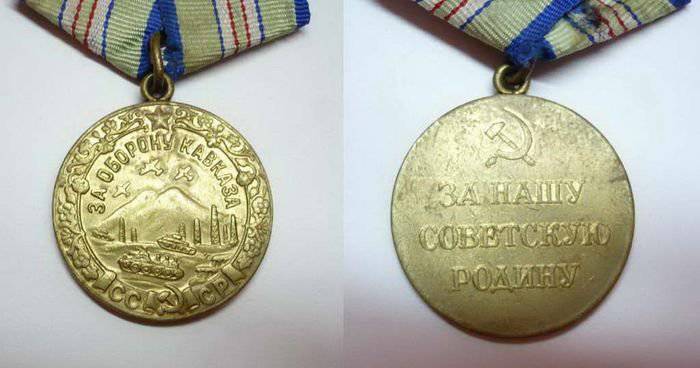
On the obverse of the medal there was an image of Mount Elbrus, at the foot of which a group of tanks and oil rigs were located. Over the top of the mountain planes were located. At the top along the circumference was the inscription "FOR THE DEFENSE OF THE CAUCASUS" (all capital letters). The bordering of the medal was made in the form of images of flowers and bunches of grapes. In the upper part of the exposition there was a five-pointed star, in the lower part there was a ribbon with the letters “USSR” on it, an image of a sickle and hammer was placed between them. The medal was attached to a five-pointed block, covered with olive tape 24 mm wide. In the middle of this tape were two white stripes 2 mm wide. Between themselves, they were divided by the same width of an olive strip. On the sides of the ribbon were strips of blue color 2,5 mm wide.
Medal "For the Defense of the Soviet Arctic"
The idea of establishing a new military medal belonged to employees of the intelligence department of the headquarters of the Karelian Front. Here several sketches of a new medal were created at once, the best of which was recognized by the drawing made by Lieutenant Colonel V. Alov. Subsequently, the idea of creating a medal was supported by the Military Council of the Karelian Front, a sketch of the medal "For the Defense of the Soviet Arctic" was sent to the capital of the USSR. In Moscow, the sketch of the medal was supplemented with individual elements that were introduced by the artist A. I. Kuznetsov.
The medal "For the Defense of the Soviet Arctic" was awarded to both the military and the civilian population of the region. All who took an active part in the protection of the territory of the USSR for at least 6 months. At the same time, servicemen who took part in offensive operations in the period from September 20 to November 1 1944, this medal was awarded regardless of their time in this theater of operations. The period of defense of the Soviet Arctic is considered to be the time period from 22 June 1941 of the year to November 1944 of the year. As of 1 January, 1995, this medal was awarded to the order of 353 240 people.
On the obverse of the medal there was a bosom image of a soldier who was wearing a cap with earflaps and a fur coat, he was holding the PCA in his hands. On the left side behind the figure of a soldier you can see the outline of a combat ship. At the top of the medal on both sides of the warrior could distinguish the contours of flying aircraft. In the lower part of the medal were images of tanks. The inscription “FOR THE DEFENSE OF THE SOVIET POLAR POLYA” (all capital letters) stretches along the circumference. At the bottom is a ribbon with a five-pointed star. The medal was attached to a pentagonal block, which was covered with a blue silk ribbon 24 mm wide. In the middle of the tape was a longitudinal green stripe of width 6 mm. The edges of the ribbon and the green strip in the middle were bordered with narrow white stripes.
Medal "For the Defense of Kiev"
This medal appeared much later than all the rest, only in 1961 year. The author of the sketch of this medal was the artist V. N. Atlantov. The medal "For the Defense of Kiev" was awarded to both military and civilians who participated in the defense of the city in parts of the people's militia, and also worked on the construction of fortifications. The period of defense of the capital of Ukraine is considered the time period from July to September 1941. As of 1 in January of 1995, approximately 107 540 people have been awarded this battle award.
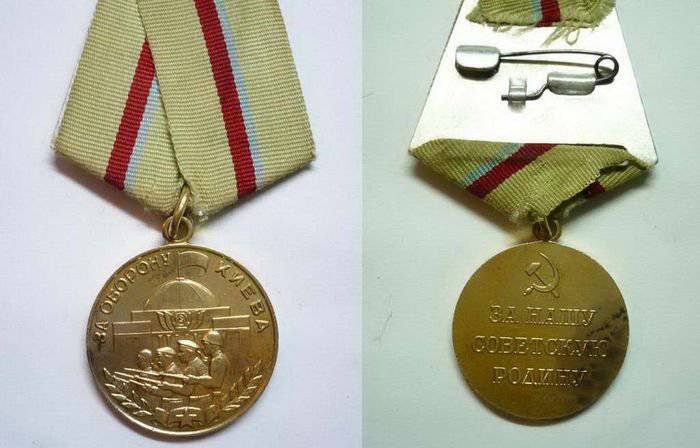
On the obverse of the award was located the contour of the building of the Supreme Soviet of the Ukrainian SSR with the flag developing above the building. Against the background of the building were images of a Soviet soldier, sailor, worker and partisan with rifles at the ready. On the circumference of the medal in its upper part was the inscription "FOR KIEV'S DEFENSE". At the bottom there was a laurel wreath. At the lower ends of the laurel branches there was a ribbon with a five-pointed star. The medal was attached to a pentagonal block covered with olive moire tape 24 mm wide. In the center of the ribbon were two longitudinal stripes - blue (2 mm) and red (4 mm).
Based on open source materials
- Yuferev Sergey
- Military orders and medals of the Soviet Union. Order of the Red Banner
Military orders and medals of the Soviet Union. The order of Lenin
Military orders and medals of the Soviet Union. Order of the Red Star
Military orders and medals of the Soviet Union. Gold Star Medal
Military orders and medals of the Soviet Union. Medal of Honor"
Military orders and medals of the Soviet Union. Medal "For Military Merit"
Military orders and medals of the Soviet Union. Order of the Patriotic War
Military orders and medals of the Soviet Union. Order of Alexander Nevsky
Military orders and medals of the Soviet Union. Order of Kutuzov
Military orders and medals of the Soviet Union. Order of Suvorov
Military orders and medals of the Soviet Union. Order of Bogdan Khmelnitsky
Military orders and medals of the Soviet Union. Medal "Partisan of the Patriotic War"
Military orders and medals of the Soviet Union. Order of Nakhimov
Military orders and medals of the Soviet Union. Order of Ushakov
Military orders and medals of the Soviet Union. Ushakov's Medal
Military orders and medals of the Soviet Union. Medal of Nakhimov
Military orders and medals of the Soviet Union. Order of Glory
Military orders and medals of the Soviet Union. Order of Victory
Military orders and medals of the Soviet Union. Medals of the series "For Defense"
Military orders and medals of the Soviet Union. Medals of the series “For the capture and release”
Military orders and medals of the Soviet Union. Medals win
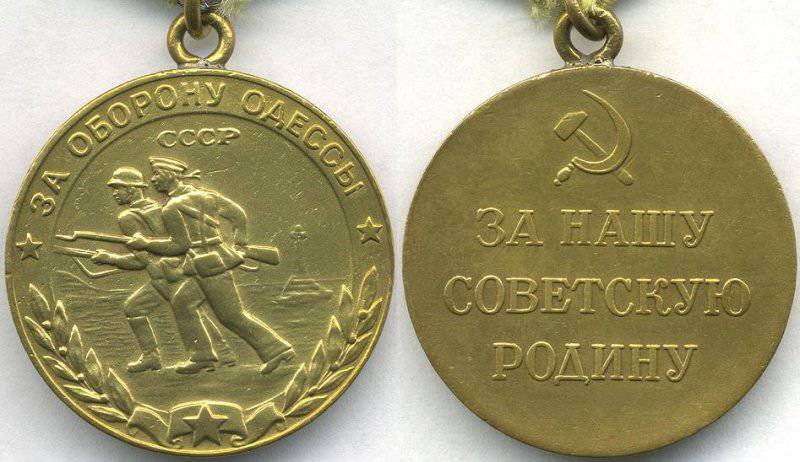
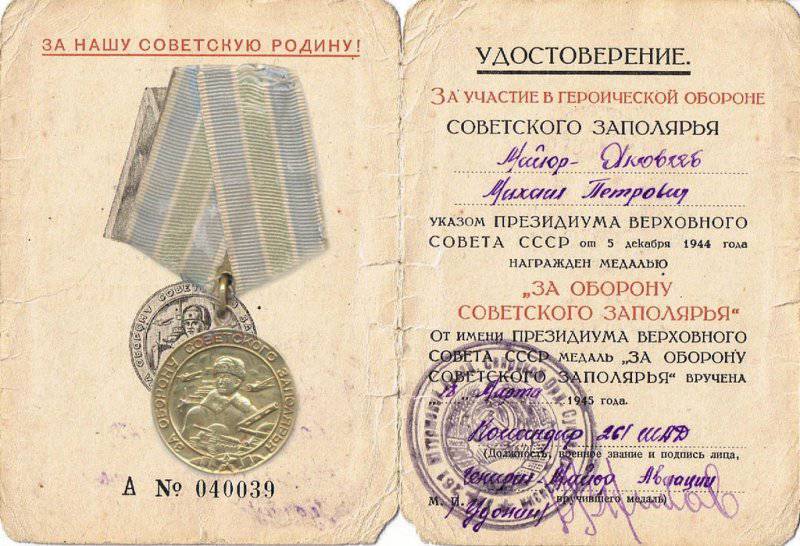
Information